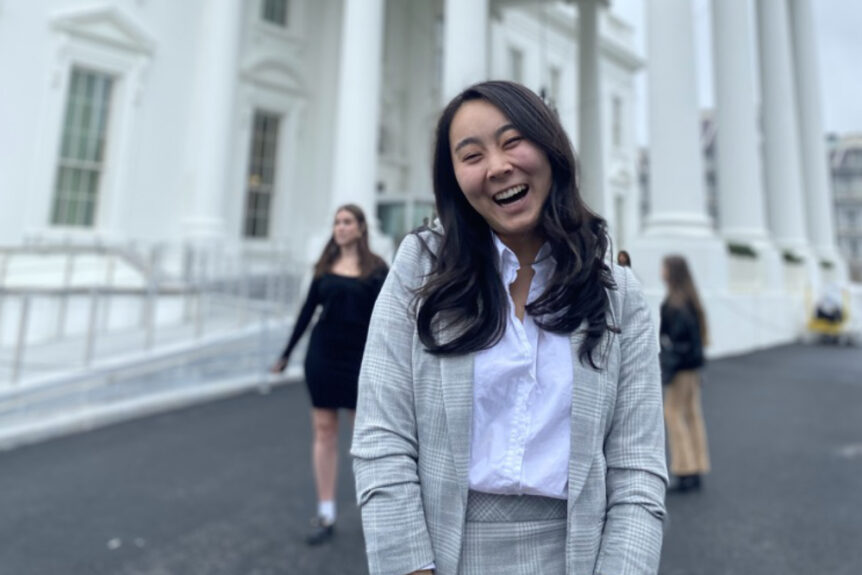Above: Taylor Unoki at the White House, March 2023.
When friends and family from my hometown heard I was headed to Ohio, I got a mixture of the same reactions: eyes widened, mouths gaping, screams of excitement, or all of the above. To me, Ohio was an enigma and I knew nothing about the state, let alone the Midwest. My field placement was anything but familiar. However, moving for the first time and being an outsider to the community I was engaging with had its limitations, but also strengths. In the process of constantly feeling and knowing I was an outsider, it opened my mind and perspective to listen more and learn. My unique position and duration of work grew my humility and forced me to think about how to best make a contribution in these six months. Ultimately, I carry one integral takeaway with me into the policy placement and beyond: that the nuances and diverse range of individuals must become the forefront of our efforts.
The importance of a spectrum and diverse sources of experience became widely apparent when I was researching and gathering quantitative data for my landscape assessment. My field placement focused on writing a landscape assessment report, which was filled with statistics and information on the geographical landscape and community demographics. Data and information plays an especially important role in this community, as a lot of the service area is rural and smaller towns. With fewer resources and minimal infrastructure in place, rural communities highlight the strengths and weaknesses of current data sources available.
Accessing U.S. Census and state data exposed how generalized and limited this data was. For instance, when analyzing data about older Americans, there were often only age groups categories for 60 and above, or 65 and above. Yet, within the community of older Americans, there are subgroups with different lived experiences and needs. Those who are 50-60 differ in physical experiences and needs than those 80 and above. With not enough data broken down to address these nuances, my report was limited and an important, prevalent community was overlooked as a result.
Furthermore, my limited time at the Second Harvest Food Bank of North Central Ohio taught me how impactful qualitative data is. Yet, it is not just about the information itself, but the way we gather it as well. With only six months at my field placement, I was only able to acquire a few quotes and statements from older Americans or BIPOC individuals. At first, I was excited to use this information to at least amplify their voices in some way in my report. However, my peers and mentors reminded me that one individual’s quote cannot possibly represent the diverse spectrum of experiences of a community. Putting these quotes without more detail and information on the group overall would have oversimplified their issues and done more harm than good. I learned to respect and prioritize the time, effort, and intentionality gathering and utilizing qualitative data takes.
However, I also saw the power of localized, nuanced data when accessible. With the help of the county health department, I was able to access all the SNAP retailers in the service area. My team and I developed a framework/rubric to assess and categorize the retailers based on the accessibility and foods and resources offered. Thanks to this specific, broken down data, we could identify areas that had insufficient SNAP assistance and meet their needs better as a result.
In Ohio, I found there is far more to be done to include all types of communities. There is little to no local, state, or federal data on LGBTQIA+ individuals, immigrants, and migrants. Having a plethora of data is important in the field and also in the policy space. In the field, it helps enhance the services and relationship with the community we are engaging with. In the policy space especially, I am learning that nuanced, community-based data is even more important to inform the policies and advocacy efforts in Washington, D.C.—to bridge the gap, just like the Emerson Hunger Fellowship strives to do.
The lessons I have been learning go beyond just applying to Ohio. Researching the rural counties of North Central Ohio was giving me a glimpse into the bigger picture of rural poverty, which comprises a disproportionate amount of the national poverty we see today. These smaller, rural areas are very diverse and dissimilar. Local communities require comprehensive qualitative and quantitative data to gain understanding that will inform long-term, effective policy. As I enter my policy placement, I look at my projects and efforts through this lens. At my policy placement, the Food Research & Action Center, this drives my passion to conduct a state-level landscape assessment, taking my time to evaluate small and big indicators. Beyond this fellowship, I am motivated to enter the policy space in the long term and push for intentional gradations of data and information. All marginalized individuals within already marginalized communities deserve to not just be accounted for, but be what we are all about.

